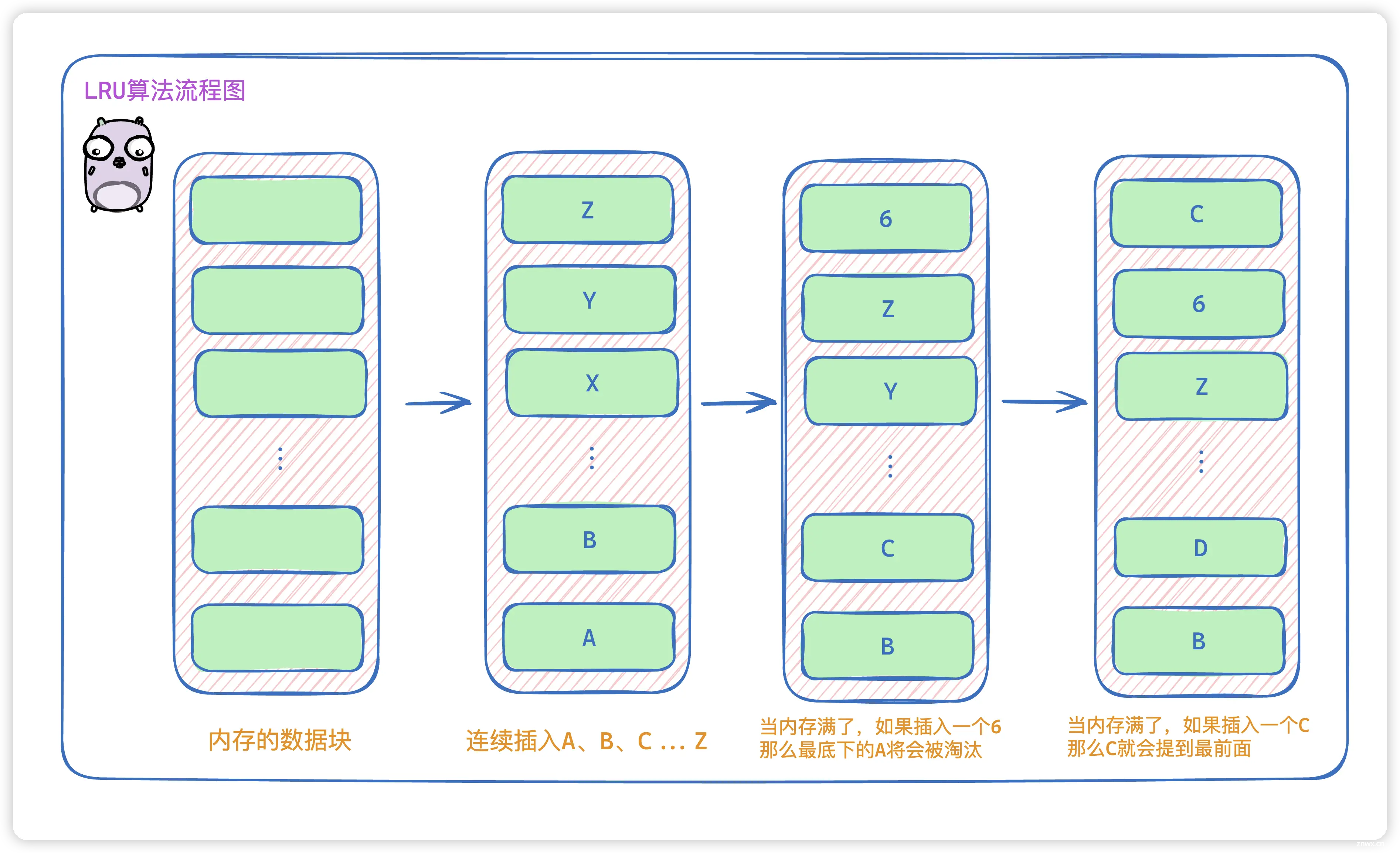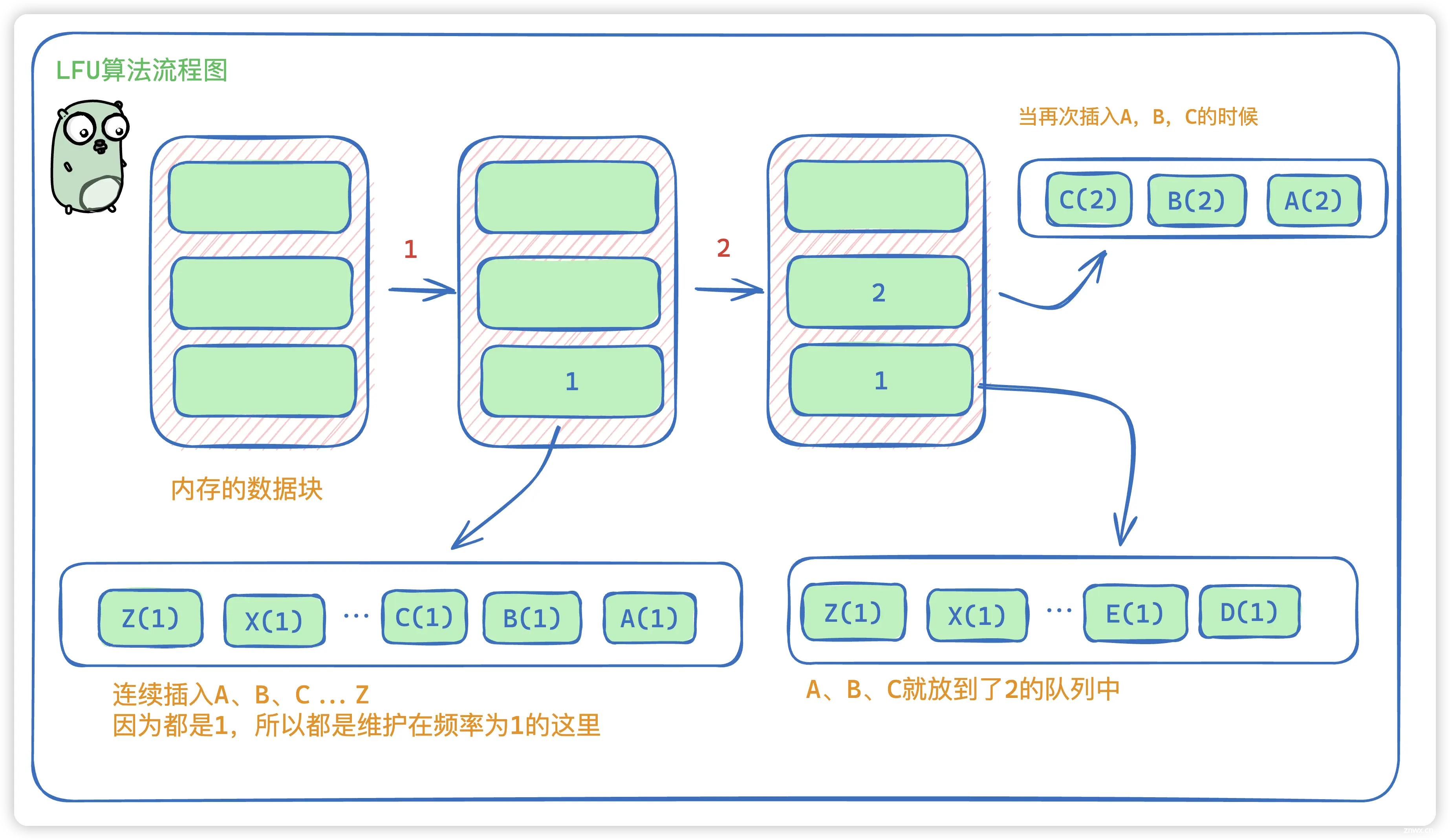图解缓存淘汰算法 LRU、LFU | 最近最少使用、最不经常使用算法 | go语言实现
小生凡一 2024-07-27 12:05:02 阅读 78
写在前面
无论是什么系统,在研发的过程中不可避免的会使用到缓存,而缓存一般来说我们不会永久存储,但是缓存的内容是有限的,那么我们如何在有限的内存空间中,尽可能的保留有效的缓存信息呢? 那么我们就可以使用 <code>LRU/LFU算法 ,来维持缓存中的信息的时效性。
LRU 详解
原理
LRU (Least Recently Used:最近最少使用)算法在缓存写满的时候,会根据所有数据的访问记录,淘汰掉未来被访问几率最低的数据。也就是说该算法认为,最近被访问过的数据,在将来被访问的几率最大。
流程如下:

假设我们有这么一块内存,一共有26个数据存储块。
当我们连续插入A、B、C、…Z的时候,此时内存已经<code>插满了那么当我们再插入一个6,那么此时会将内存存放时间最久的数据A淘汰掉。当我们从外部读取数据C的时候,此时C就会提到头部,这时候C就是最晚淘汰的了。
其实流程来说很简单。我们来拆分一下的话,不难发现这就是在维护一个双向链表。
代码实现
定义一个存放的数据块结构
type item struct {
key string
value any
// the frequency of key
freq int
}
定义LRU算法的结构体
type LRU struct {
dl *list.List // 维护的双端队列
size int // 当前的容量
capacity int // 限定的容量
storage map[string]*list.Element // 存储的key
}
获取某个key的value的函数,如果存在这个key,那么我们就把这个值移动到最前面MoveToFront,否则返回一个nil。
func (c *LRU) Get(key string) any {
v, ok := c.storage[key]
if ok {
c.dl.MoveToFront(v)
return v.Value.(item).value
}
return nil
}
当我们需要put进去一些东西的时候。会分以下几个步骤
是否已经存在,如果已经存在则,直接返回,并且将key移动到最前面。如果没有存在,但是已经是到极限容量了,就把最后一个Back(),淘汰掉,然后在塞入。塞入的话,是塞入到最前面PushFront
func (c *LRU) Put(key string, value any) {
e, ok := c.storage[key]
if ok {
n := e.Value.(item)
n.value = value
e.Value = n
c.dl.MoveToFront(e)
return
}
if c.size >= c.capacity {
e = c.dl.Back()
dk := e.Value.(item).key
c.dl.Remove(e)
delete(c.storage, dk)
c.size--
}
n := item{ key: key, value: value}
c.dl.PushFront(n)
ne := c.dl.Front()
c.storage[key] = ne
c.size++
}
以上就是LRU算法的所有内容了,那我们看一下LFU算法。
LFU
原理
LFU全称是最不经常使用算法(Least Frequently Used),LFU算法的基本思想和所有的缓存算法一样,一定时期内被访问次数最少的页,在将来被访问到的几率也是最小的。
相比于LRU(Least Recently Use)算法,LFU更加注重于使用的频率 。LRU是其实可以看作是频率为1的LFU的。

和LRU不同的是,LFU是根据频率排序的,当我们插入的时候,一般会把新插入的放到链表的尾部,因为新插入的一定是没有出现过的,所以频率都会是1 , 所以会放在最后。
所以LFU的插入顺序如下:
如果A没有出现过,那么就会放在双向链表的最后,依次类推,就会是Z、Y。。C、B、A的顺序放到频率为1的链表中。当我们新插入 A,B,C 那么A,B,C就会到频率为2的链表中如果再次插入A,B那么A,B会在频率为3中。C依旧在2中如果此时已经满了 ,新插入一个的话,我们会把最后一个D移除,并插入 6

代码
定义一个<code>LFU的结构体:
// LFU the Least Frequently Used (LFU) page-replacement algorithm
type LFU struct {
len int // length
cap int // capacity
minFreq int // The element that operates least frequently in LFU
// key: key of element, value: value of element
itemMap map[string]*list.Element
// key: frequency of possible occurrences of all elements in the itemMap
// value: elements with the same frequency
freqMap map[int]*list.List // 维护一个频率和list的集合
}
我们使用LFU算法的话,我们插入的元素就需要带上频率了
// initItem to init item for LFU
func initItem(k string, v any, f int) item {
return item{
key: k,
value: v,
freq: f,
}
}
如果我们获取某个元素,那么这个元素如果存在,就会对这个元素的频率进行加1
// Get the key in cache by LFU
func (c *LFU) Get(key string) any {
// if existed, will return value
if e, ok := c.itemMap[key]; ok {
// the frequency of e +1 and change freqMap
c.increaseFreq(e)
obj := e.Value.(item)
return obj.value
}
// if not existed, return nil
return nil
}
增加频率
// increaseFreq increase the frequency if element
func (c *LFU) increaseFreq(e *list.Element) {
obj := e.Value.(item)
// remove from low frequency first
oldLost := c.freqMap[obj.freq]
oldLost.Remove(e)
// change the value of minFreq
if c.minFreq == obj.freq && oldLost.Len() == 0 {
// if it is the last node of the minimum frequency that is removed
c.minFreq++
}
// add to high frequency list
c.insertMap(obj)
}
插入key到LFU缓存中
如果存在就对频率加1如果不存在就准备插入如果溢出了,就把最少频率的删除如果没有溢出,那么就放到最后
// Put the key in LFU cache
func (c *LFU) Put(key string, value any) {
if e, ok := c.itemMap[key]; ok {
// if key existed, update the value
obj := e.Value.(item)
obj.value = value
c.increaseFreq(e)
} else {
// if key not existed
obj := initItem(key, value, 1)
// if the length of item gets to the top line
// remove the least frequently operated element
if c.len == c.cap {
c.eliminate()
c.len--
}
// insert in freqMap and itemMap
c.insertMap(obj)
// change minFreq to 1 because insert the newest one
c.minFreq = 1
// length++
c.len++
}
}
插入一个新的
// insertMap insert item in map
func (c *LFU) insertMap(obj item) {
// add in freqMap
l, ok := c.freqMap[obj.freq]
if !ok {
l = list.New()
c.freqMap[obj.freq] = l
}
e := l.PushFront(obj)
// update or add the value of itemMap key to e
c.itemMap[obj.key] = e
}
找到最少的链表,并且删除
// eliminate clear the least frequently operated element
func (c *LFU) eliminate() {
l := c.freqMap[c.minFreq]
e := l.Back()
obj := e.Value.(item)
l.Remove(e)
delete(c.itemMap, obj.key)
}
以上就是所有LFU的算法实现了。
声明
本文内容仅代表作者观点,或转载于其他网站,本站不以此文作为商业用途
如有涉及侵权,请联系本站进行删除
转载本站原创文章,请注明来源及作者。